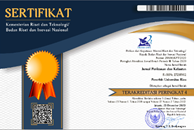Fish Coolbox using Coconut Fiber (Cocos nucifera) and Baggage (Saccharum sp) Insulated
(1) Department of Fisheries, Faculty of Fisheries and Marine Sciences, Teuku Umar University
(2) Department of Fisheries, Faculty of Fisheries and Marine Sciences, Teuku Umar University
(3) Department of Fisheries, Faculty of Fisheries and Marine Sciences, Teuku Umar University
(4) Department of Fisheries, Faculty of Fisheries and Marine Sciences, Teuku Umar University
(5) Department of Aquatic Resources, Faculty of Fisheries and Marine Sciences, Teuku Umar University
(*) Corresponding Author
Abstract
Keywords
Full Text:
PDFReferences
Amin, M., Samsudi, R. (2010). Pemanfaatan Limbah Serat Sabut Kelapa Sebagai Bahan Pembuat Helm Pengendara Kendaraan Roda Dua. Prosiding Seminar Nasional & Internasional, 3(1): 50-65
Arif, S. (2021). Penggunaan Komposit Sekam Padi sebagai Pengganti Dinding Box Pendingin Ikan. Universitas Muhammadiyah Sumatera Utara. Medan.
Husein, M.A. (2018). Analisis Penggunaan Serat Ijuk dan Sbut Kelapa sebagai Insulator Ruang Muat Kapal Jenis Purse Seine. Institut Teknologi Sepuluh Nopember. Surabaya.
Maiwita, F. (2014). Pengaruh Variasi Komposisi Ampas Tebu dan Serbuk Gergaji pada Papan Partikel terhadap Konduktivitas Termal. Pillar of Physics, 3(1).
Meirsaguna, D.A. (2016). Program Diet Kantong Plastik Sebagai Upaya Penanggulangan Masalah Sampah Plastik Dikota Bandung. Universitas Pasundan Bandung. Bandung.
Nashrullah, I. (2018). Analisa Performa Kotak Pendingin pada Kapal Nelayan Tradisional Menggunakan Insulasi Campuran Kayu Mahoni (Swietenia macrophylla) dan Serat Kapuk. Institut Teknologi Sepuluh Nopember. Surabaya.
Nasution, P., Fitri, S.P., Semin. (2014). Karakteristik Fisik Komposit Sabut Kelapa Sebagai Insulator Palka Ikan. Jurnal Berkala Perikanan Terubuk, 42 (2): 82-92.
Pratama, N. (2016). Pengaruh Variasi Ukuran Partikel terhadap Nilai Konduktivitas Termal Papan Partikel Tongkol Jagung. Pillar of Physics, 7(1).
Sana, A.W., Noerati, N., Sugiyana, D., Sukardan, M.D. (2020). Aplikasi Serat Alam Biduri (Calotropis gigantea) Sebagai Bahan Pengisi Insulatif pada Jaket Musim Dingin, Arena Tekstil, 35(1): 1-12.
Setiawan, H. (2006). Analisa Pengaruh Pemanfaatan Es Kering pada Coolbox Kapal ikan Tradisional Terhadap Kualitas Ikan. Institut Teknologi Sepuluh Nopember. Surabaya.
Tjahjanti, P.H. (2019). Buku Ajar Pengetahuan Bahan Teknik. Sidoarjo. Umsida Press.
Utomo, R.A. (2019). Analisa Pemanfaatan Pelepah Salak dan Kulit Salak Sebagai Campuran Bahan Insulasi Palka Kapal Ikan Tradisional. Institut Teknologi Sepuluh November. Surabaya.
Wardani, M.K. (2017). Pemanfaatan Ampas Tebu dan Serbuk Gergaji Sebagai Bahan Insulasi Pada Kotak Pendingin. Institut Teknologi Sepuluh November. Surabaya
Article Metrics
Abstract view : 57 timesPDF - 70 times
DOI: http://dx.doi.org/10.31258/jpk.28.3.361-366
Copyright (c) 2023 Muhammad Agam Thahir, Nurlaili Nurlalili, Ikhsanul Khairi, Syarifah Zuraidah, Muhammad Arif Nasution

This work is licensed under a Creative Commons Attribution-NonCommercial-NoDerivatives 4.0 International License.
Gedung Marine Center Lt 2. Fakultas Perikanan dan Kelautan Universitas Riau



